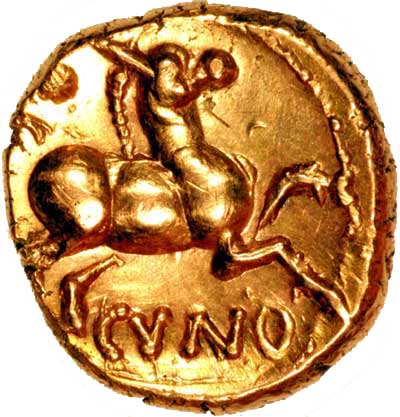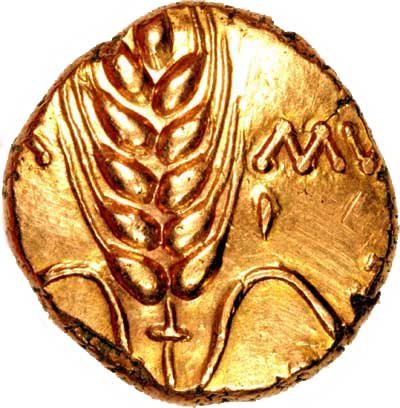| Gold Coins
Four millennia of gold coin production and use - a brief history. The First Gold Coins Lydia 643 BC
The Midas Touch These gold deposits were believed to have originated by King Midas washing himself in the river to cleanse himself of his "golden touch" which had the inconvenient effect of turning even his food into gold. Gold And Silver By about 560 B.C., the Lydians and Ionians had learned how to separate the gold from the silver, so that King Croesus was able to issue the world's first bi-metallic coinage. Bi-metallic in the sense that there were gold coins and silver coins. Shortly afterwards, in 546 B.C., Croeseus was captured by the Persians, who came to adopt gold as the main metal for their coins. Gold Or Silver? The Greeks to the west of Ionia believed that silver should be the main metal used for coins. Following this there have, for most of history, been regions which favoured silver and other nations which favoured gold as their main coinage and currency metal. Where the two existed side by side, then gold was usually considered the more important. In most cases, ready availability of one metal rather than the other exerted a practical influence over the choice. The Celts
The Romans The early Roman Republic issued few coins in gold, their main coinage being in silver, with bronze or copper for small change. From the death of Julius Caesar, gold coinage came to be an important part of the Roman coinage system. The Romans took a very practical view in exploiting natural resources in the areas of their conquest, and issued coins in gold, silver, and copper according to the resources of the region. The First Sovereign The First One Pound Coin The gold sovereign came into existence in 1489 under King Henry VII. The Pound Sterling The pound sterling had been a unit of account for centuries, as had the mark. Now for the first time a coin denomination was issued with a value of one pound sterling. This new coin weighed 240 grains which equals 0.5 troy ounces or 15.55 grams, and was made using the standard gold coinage alloy of 23 carat, equal to 95.83% fine. The First Design
Leading Designer of the Age
Doubles and Trebles
Henry VIII And The First Half Sovereign
Edward VI Under Edward VI, sovereigns, half sovereigns, and double sovereigns were struck. His first sovereigns, issued between January 1549 and April 1550, were only in 22 carat gold. From 1550 to 1553, "fine" sovereigns were once again issued with a value of thirty shillings, and also a "standard" sovereign at twenty shillings. Mary During the sole reign of Mary, "fine" sovereigns were struck with a value of thirty shillings (30/- or 30s.), but during her slightly longer joint reign with Philip, no sovereigns were issued. Elizabeth I During the long reign of Elizabeth II, "fine" gold sovereigns, with a very high (99.4%) gold content, continued to be issued with a value of thirty shillings. A separate one pound gold coin was also issued, obviously with a value of twenty shillings. James I - The Unite Appears In the first coinage of James I, from 1603 to 1604, sovereigns of twenty shillings were issued before being discontinued, the previous pound coin was made lighter and renamed as a "unite". So after 115 years, this was the last sovereign to be issued until the emergence of the modern gold sovereign in 1817. Unites Laurels and Guineas The Unite Replaces The Sovereign From James I's second coinage in 1604, the sovereign was discontinued in favour of the "unite", also valued at one pound. It was called a unite to mark the unification of England and Scotland upon the accession of James VI of Scotland to the British throne, as James I of England. The Laurel Comes and Goes In 1612 the unite was revalued at 22 shillings, and in 1619 was replace by a lighter one pound coin known as the laurel. The laurel weighed 140.5 grains. The Unite Continues The unite was continued in the reign of Charles I, being again valued at twenty shillings, and continued in production during "The Commonwealth", and the early hammered coinage of Charles II until 1662. Machine Made Guineas Arrive With the introduction of regular machine made "milled" coinage under Charles II, the guinea was introduced in 1668. It was so called because the gold from which many were made was imported from the African state of Guinea by the Africa Company. The badge of logo of The Africa Company was an elephant and castle (howdah), and this symbol, or sometimes just the elephant appeared on many of the guineas. When a Guinea was a Pound
The Modern Sovereign New Coinage - New Mint In 1816, there was a major change in the British coinage, powered by the Industrial Revolution. The Royal Mint moved from The Tower of London to new premises on nearby Tower Hill, and acquired powerful new steam powered coining presses designed by Matthew Boulton and James Watt. the modern sovereign was born! Saint George & The Dragon A new reverse design was introduced featuring Saint George slaying a dragon, designed by a brilliant young Italian engraver, Benedetto Pistrucci. This beautiful classic design remains on our gold sovereigns today, almost two hundred years later, and for most of its life must have been one of the worlds most widely recognised coins. Gold Gives Way To Paper The First British Paper Money Although the first "banknote", actually a goldsmith's note, known to exist was issued by Laurence Hoare in 1633, and the earliest known cheque was issued in 1659. Paper money did not supersede metal until the second decade of the 20th century. Royal Mint Stops Gold Sovereign Production During the first world war, Britain needed gold bullion to finance the war effort. Banknotes were introduced into regular circulation, and within a few years, the gold sovereign ceased to be used in everyday transactions. Production at the Royal Mint stopped in 1917, although some were minted again in 1925. Commonwealth Mints The branch mints continued to produce sovereigns, Ottawa in Canada until 1919, Bombay in India in 1918, Sydney Australia until 1926, Melbourne and Perth Australia until 1931, and Pretoria South Africa until 1932. 1933 - The End of The World for Gold Coinage
The Investment Market A number of countries continued to issue gold coins for purchase by investors in the period from the end of the first world war. This has usually been to supply domestic demand for citizens to maintain a "hedge" against currency fluctuations or failures, and against political upheaval. Central and National Banks will have kept many of the previously circulating gold coins as part of their gold bullion holdings, many will have been melted down, and others will have been re-issued to meet demand. Premium Prices Increasingly from about 1914, gold coins were traded at a premium to their gold content, especially as most countries did not regularly issue any new gold coins. Certain gold coins have been internationally recognised, these include the British gold sovereign, the American double eagle, and the Swiss twenty francs. Many other types of gold coins had a popularity within their more immediate neighbouring countries, with linguistics also playing their part in the supply - demand situation. There is an obvious logic and attraction in using gold coins whose inscriptions the owner could easily read. Low Premiums & International Bullion Coins
Special Occasions
|

|
32 - 36 Harrowside, Blackpool, Lancashire, FY4 1RJ, England. Telephone (44) - (0) 1253 - 343081; Fax 408058;
E-mail: Contact Us The URL for our main page is: taxfreegold.co.uk

